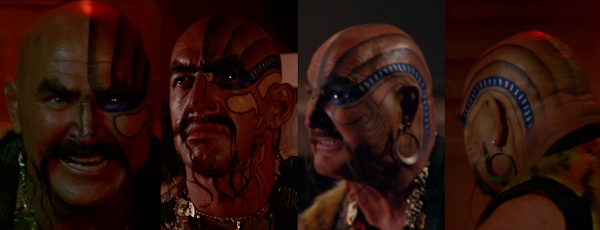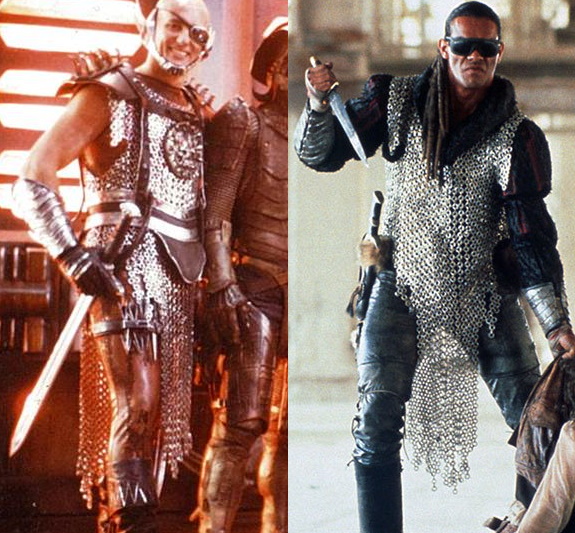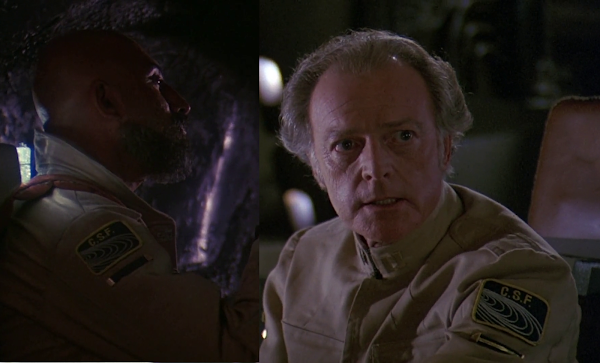Now, this may seem like a bit of an odd choice to talk about here; after all, it's not actually costumes, real tangible objects that exist and remain after filming is done. But really, I feel makeup in movies is adjacent to costume design as it is also about establishing a look for a character, and often the costume designer has a hand in designing the look of the facial makeup; this happens with special makeup effects as well, where the special effects teams will follow from the costume designer's sketches.
This is going to be mostly focused on cult and exploitation film; the characters donning facepaint usually tend to be evil occultists or violent punks, with some exceptions. The inspiration tends to come mostly from either various indigenous cultures - Native American, African, Pacific Islander, Maori, etc - or from more contemporary sources such as musicians (Arthur Brown, Peter Gabriel or KISS come to mind) or wrestlers, though how much the latter takes inspiration from the former is up for debate!
For the sake of my own time, not *every* bit of facial makeup in a movie will be included; anything as minimal as the makeup worn by Malcolm McDowell in A Clockwork Orange will not be included, and clown/mime makeup will also not be included due to redundancy. Additionally, riffs on such bands as KISS are not included, nor are movies with 'tribal' characters, as they're often copies of real-world tribal facepaint.
Mr. Freedom (1969)
Assorted facepaint makeups in red, blue and white; the colours of the Stars and Stripes, as per the film's satirical critique of American imperialism.
Brewster McCloud (1970)
Shelley Duvall sported this Raggedy Ann pastiche facepaint for the finale of the Robert Altman film.
Godzilla vs. Hedorah (1971)
A fish-inspired facepaint makeup is worn on a singer in this famously oddball entry in the
Godzilla series.
Kamen Rider (1971)
Agents of the villainous 'Shocker' organization wear green and red wavy facepaint, even when performing medical duties.
Blood Orgy of the She-Devils (1973)
Skirts the line between facepaint and beauty makeup, but it's elaborate and striking enough to count on here; love that there's silver *and* gold inside the red lining.
Live and Let Die (1973)
Geoffrey Holder sports two facepaint designs in his turn as Baron Samedi. The first is a half-face white makeup, that in the film's final shot is altered so the painted half has his natural lips showing, while the unpainted half has his lips painted white.
The second is a half-face corpsepaint makeup design with painted bones across his body.
The Burning Hell (1974)
None other than Satan himself wears this elaborate facial makeup in the infamous Christian propaganda 'classic'.
Phantom of the Paradise (1974)
Brian De Palma's seminal satire of the music industry has a parodic take on Alice Cooper et al in the form of 'The Undeads' wearing stylized black and white facepaint, before KISS made it cool (or uncool, depending on your opinion on KISS); and of course, who can forget Gerrit Graham's silvery bodypaint?
The Rocky Horror Picture Show (1975)
Some very mime-inspired facial makeups in the iconic cult classic, though I also included an image from the original stage play!
The Tomorrow People 'Worlds Away' (1975)
Two forest dwellers of the planet Pyrie wear multicoloured facial makeups utilizing woodland colours.
Doctor Who 'The Brain of Morbius' (1976)
Members of the flame-worshipping Sisterhood of Karn sport gold facial makeup with detailed flame markings around the eyes.
Doctor Who 'The Robots of Death' (1977)
David Bailie sports this shiny makeup in his turn as the robot supremacist Taren Capel; does this read as being a little inspired by Peter Gabriel to you as well?
Jubilee (1978)
Pamela Rooke sported her iconic pink geometric makeup design in Derek Jarman's tribute to London's punk subculture.
Buck Rogers in the 25th Century (1979)
A half-face patterned makeup was applied to Duke Butler and H.B. Haggerty in their turns as the 'Tigerman'.
Ring of Darkness (1979)
A hexagram facepaint pattern adorns the coven's leader in this schlocky Italian ripoff of
Rosemary's Baby and
The Omen; sublime Stelvia Cipriani soundtrack though!
The Warriors (1979)
One of the most iconic images from Walter Hill's larger-than-life cult classic; the facepaint was the idea of costume designer Bobbie Mannix, who denied any inspiration from
A Clockwork Orange or KISS; I can see it, the facepaint looks much more inspired by indigenous facepaint, fitting with the 'tribalism' theme of the film.
Crazy Thunder Road (1980)
Sogo Ishii's directorial debut revolving around a biker gang; one of them sports this very elaborate technicolour face makeup.
Blake's 7 'Stardrive' (1981)
The 'Space Rats' are a futuristic spin on biker gangs and punks, so of course they sport garish makeup, especially the yellow and black design sported by Damien Thomas; only one of his underlings has their facepaint clearly visible.
Conan the Barbarian (1982)
At least two notable bodypaint designs are seen in John Milius' adaptation of Robert E. Howard's Conan stories. The first is an elaborate bodypaint design sported by Franco Columbo as the otherwise unnamed 'Pictish Scout', inspired by the motif that Scotland's ancient Pict peoples may have painted their bodies.
The second bodypaint design, sported on Arnold Schwarzenegger, Sandahl Bergman and Gerry Lopez during the raid on Thulsa Doom's palace, is a primitive spin on modern camouflage painting, consisting of black streaks over their faces, arms and torsos.
Liquid Sky (1982)
Several bold and garish facial makeup jobs were applied on various performers in this arthouse send-up of New Wave makeup and fashion.
The Last Horror Film (1982)
A lovely blue and white makeup pattern was sported by Joe Spinell in this meta spoof on the horror genre.
Blade Runner (1982)
A rather colourful wheel-shaped makeup is sported by a dancer in the Snake Pit scene, though only seen clearly in one promotional photo, sadly.
1990: The Bronx Warriors (1982)
The 'Iron Man' tapdancing gang, taking some cues from the Baseball Furies of
The Warriors, sport flame-patterned warpaint. Other characters in the film wear less garish, but still odd facepaint makeups, with one character sporting a corpsepaint-like design.
Endgame: Bronx Lotta Finale (1983)
The fighters of the titular deathsport, as well as some other extras, sport rather New Wave inspired facepaint; special mention to George Eastman's red, silver and black design.
2020 Texas Gladiators (1983)
Another low-budget Italian
Mad Max wannabe, with some of the wasteland bandits sporting 'tribal' facepaints.
Warrior of the Lost World (1983)
Yet another cheap Italian post-apocalypse film, with more garish makeups; the highlight is the black and white checkerboard pattern sported by one of the wasteland thugs, though of course there's the usual New Wave eye makeups!
Spacehunter: Adventures in the Forbidden Zone (1983)
A sadly unused facial makeup was designed for Molly Ringwald's turn in the
Star Wars/
Mad Max hybrid oddity, sadly only seen in these promotional photos.
The Boxer's Omen (1983)
The evil magician in this Hong Kong cult classic sports facepaint that seems a little inspired by Papa New Guinea traditional makeup.
The Toxic Avenger (1984)
One hoodlum sports this rather fetching half-face black and red makeup, with accentuated lipstick on the unpainted side - rather glam!
Indiana Jones and the Temple of Doom (1984)
Infamously racist for yknow, demeaning an entire religion's deity as some sub-Satanist cult, but the Thuggee cultists so sport some great outfits complemented with facial makeup; the priests wear corpsepaint (inspired by Baron Samedi?) while the warriors sport a red pattern.
The Midnight Hour (1985)
A bold, geometrically patterned blue and white face makeup is sported by a Halloween partygoer in this family oriented horror special.
Vamp (1986)
The iconic Grace Jones stars as a vampire queen in this cult classic, sporting a bodypaint job designed and applied by none other than Keith Haring; Haring and Jones had collaborated previously before,
which can be read about more in this article from Artland Magazine. For the
Vamp assignment however, Haring's bodypaint is completed with a mime-like white face makeup.
Unmasking the Idol (1986)
Janet Nease sports a red, blue and gold glitter facial makeup in this rather unfunny James Bond/Indiana Jones b-movie spoof; it's better than
Order of the Black Eagle, at least.
Class of Nuke 'Em High (1986)
The 'Cretins' gang in Troma's delightfully trashy entry in the punksploitation trend sport some very elaborate facial makeups.
Terminus (1987)
Arthouse-influenced French scifi thriller where the protagonists are harassed by soldiers sporting ornate facial makeup; Enki Bilal was involved on the film and this may have been his influence, due to similar facepainted fascists being present in his Nikopol comics trilogy.
The Barbarians (1987)
Various tribesmen in the schlocky Ruggero Deodato Conan the Barbarian ripoff sport colourful facial makeup jobs.
The Lair of the White Worm (1988)
Ken Russell's deliciously kinky gothic horror has Amanda Donohoe sporting this full bodypaint, with dark blue detailing around her face with streaks along the hair; more complex makeup design was applied to the male extras during one hallucination sequence. I think at least some of these designs were inspired by Nuba facepaint but in a blue tone.
The Toxic Avenger Part III (1989)
One thug sports this ornate half-face makeup depicting waves and rain drops; the actor's hair's been shaved for this no less.
Howling VI: The Freaks (1991)
A circus freakshow themed entry in the tired
Howling series, among its number is a circus jester and bird-biting geek who sports this elaborate red, white and black facepaint design.
Shock 'Em Dead (1991)
Very silly low-budget rock-themed horror flick, with Tyger Sodipe sporting some elaborate facepaint makeups as the otherwise unnamed 'Voodoo woman'. The red makeup feels inspired by indigenous tribal facepaints.
Wittgenstein (1993)
Derek Jarman's surrealistic biography of philosopher Ludwig Wittgenstein has Tilda Swinton sporting a garish facepaint design of blue, yellow and red.
TC 2000 (1993)
Various wasteland thugs sport elaborate facial makeup; Jalal Merhi sports to distinctive designs, one a colourful wavy pattern and the other a half-face yellow and black design.
Tales from the Crypt 'Food for Thought' (1993)
As I said, I don't include clown makeups, as they are the same few designs. However, I'm making an exception for the facepaint design that Ernie Hudson sports as the sinister Zambini, thanks to its sinister lining and gold colour. Gold is typically a colour *not* used on clown makeups.
Star Trek: Deep Space Nine 'Rules of Acquisition' (1993)
The 'Dosi' aliens sport a variety of red and white face patterns, with blue dots and streaks going down to the chest; Brian Thompson and Emilia Crow get the most screentime, but many more patterns were made for the various extras, most of them never being seen properly on-screen.
Death Machine (1994)
Martin McDougall sports this red half-face makeup, slightly makes me think of a 'target' motif, fitting the character's warrior nature.
No Escape (1994)
A few of the extras playing the feral inmates of the 'Absolon' island prison sport tribal-inspired makeups, in particular the blue pattern that feels indebted to Maori tattoos.
Lunarcop (1995)
Billy Drago dons a colourful warpaint makeup during the final battle in this forgotten Michael Pare post-apocalyptic action vehicle.
Johnny Mnemonic (1995)
Slightly more minimalistic black facial makeup markings were applied to the various 'Lo Tek' extras.
Star Trek: Voyager 'The Thaw' (1996)
A futuristic spin on clown makeup was sported by Michael McKean in his turn as a futuristic clown in this off-kilter episode. A colourful, albeit more mnimal makeup was also sported by Patty Maloney in this episode, but it barely gets a good shot sadly.
Dungeons & Dragons (2000)
One or two makeup jobs are worn by extras in this maligned fantasy film; I have no idea if it's meant to be tribal facepaint or even meant to be some sort of non-human character, but still, it counts. Notice that the green paintjob changes on the same performer!
Ghosts of Mars (2001)
Various 'tribal' and corpsepaint-a-like makeups are worn by the possessed maniacs in Carpenter's scifi actioner. Almost all of these, barring the last shot, were taken from behind the scenes material; none of them are properly visible in the film itself.
The Wicker Man (2006)
A particularly loathed remake, but I do find these makeup designs worn by the cultists to be kinda charming, especially the alternating blue and white design sported by Ellen Burstyn, which even has the lipstick split in two colours!
Doomsday (2008)
An ornate face makeup is sported by Lee-Anne Liebenberg as the warrior 'Viper' in Neil Marshall's schlocky Scotch tribute to 1980s action films; the design feels like a combination of Maori tattoos and New Wave eyelining makeups.






































































































